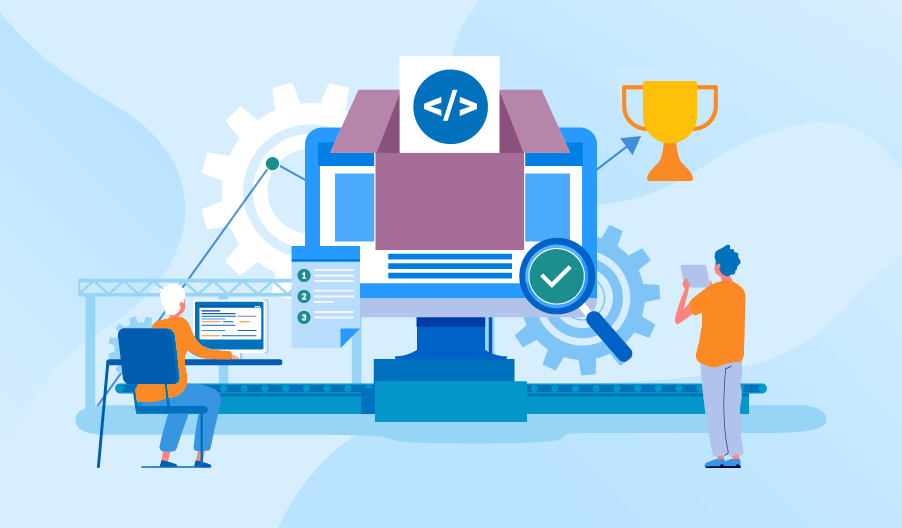A Winning Strategy for Software Product Testing
Editor’s note: Tanya shares proven QA practices for you to implement in order to support your software product growth. Read on for some useful tips and study our offer in software QA outsourcing for in-depth QA assistance.
The competition puts pressure on product companies to grow and evolve fast. In response to that, product companies – from maturing startups to established software product vendors – aim to deliver new functionality quickly, so that they can meet the needs of their customers and acquire new ones. A common issue in this race is that the testing processes companies used to rely on no longer support the newly introduced growth strategies. And due to the ill-fitted testing processes, the in-house test teams or QA vendors fail at ensuring product quality in the conditions of faster development.
So, as a product company, how can you win over customers with quickly delivered desired functionality and keep product quality high? My experience in software product testing proves that you need to start with introducing a structured testing process tailored to the peculiarities of your software product and project.

Establishing a testing process for a software product
I refer to the testing process as a set of systematically performed quality control activities, which lays the groundwork for both improving product quality and increasing the efficiency of the test teams. A model testing process includes the following stages, which can be tweaked to project and product specifics:
- Software product requirements analysis.
- Test planning (including the planning of non-functional testing activities, e.g., performance, usability, compliance testing).
- Test design.
- Test execution and defect reporting.
- Retesting and regression testing.
- Release and user acceptance testing.
Learn more about each stage of the testing process in this article.
A basic testing process comprised of the steps above can already drive significant quality improvements to your software product. For instance, a structured testing process ScienceSoft introduced for a security audit software provider during QA consulting, allowed the customer to achieve a 25% reduction in software product testing time and make sure no critical defect entered the production.
Still, there are startups and small product companies tempted to put off testing until the later stages of their product life cycle. I strongly believe that this option is not feasible since putting off testing until the first version of a product is released and the project team start working on the product growth creates problems. Thus, you will not only have to evolve your product fast but also search for and fix old defects that emerged at the initial product development stage. It is estimated that the defects found at the post-release stage may cost 15 times more than the ones found at a product design stage.
It is more efficient both in terms of product quality and project costs to start testing early. And after the first product version is released, you can evolve faster as you’ll have a quality basis for product growth.
Increasing testing process efficiency further
To support product growth and speed up the testing process even further, consider taking up the following practices:
Introducing an appropriate share of test automation
My practice shows that UI-level test automation alone can help reduce testing time by 25% without affecting the software quality. However, to make sure your test automation initiative is a success, you need to carefully assess the feasibility of test automation for your project, single out the test cases that are to be automated, decide on the levels of testing test scripts will be run on (API, UI), choose appropriate test automation frameworks and design a test automation architecture that would bring ROI. Thus, if you feel like lacking these competencies, I recommend turning to a vendor specializing in test automation.
Taking a risk-based approach to testing
Optimize the time it takes to perform testing activities while making sure that critical software product modules are carefully verified. For that, analyze the functional modules of the software product based on the probability and impact of defects and classify the software modules accordingly. Concentrate on testing high-risk software modules and optimize efforts required for the verification of modules with low-risk probability – such modules can be covered with unit tests only or tested indirectly.
Increasing the share of tests executed at the unit and API levels
If your aim is short release cycles with frequent software product updates, opt for unit and API-level tests as the primary means of validating changes introduced to the application logic. While UI-level tests are quite difficult and expensive to maintain, tests executed at the unit and API levels are relatively easy to write and do not take up much time to execute. They allow gaining insight into the quality of changes introduced to an application and help prevent defects from entering later stages of the delivery cycle.
Integrating incremental, automatically triggered testing activities throughout a unit and API levels
Integrate test automation frameworks with automation servers, such as Jenkins, Bamboo, etc. This will enable you to trigger automatic test execution and run tests in parallel. For instance, validating an image processing software product for our customer, we set up unit tests to be executed 15 minutes after each new code commit. The customer’s development team managed to achieve up to 30 commits a day per developer.
Release a quality product fast
Product companies should cater for quality product growth to be able to outrun the competition, and a well-thought testing process lays the basis for consistently evolving the product, while keeping its quality high. For 36 years, ScienceSoft has been helping companies deliver quality products that win customers fast. If you need assistance in designing an optimal testing process or executing testing activities for your software product, you are welcome to leave us a request.

